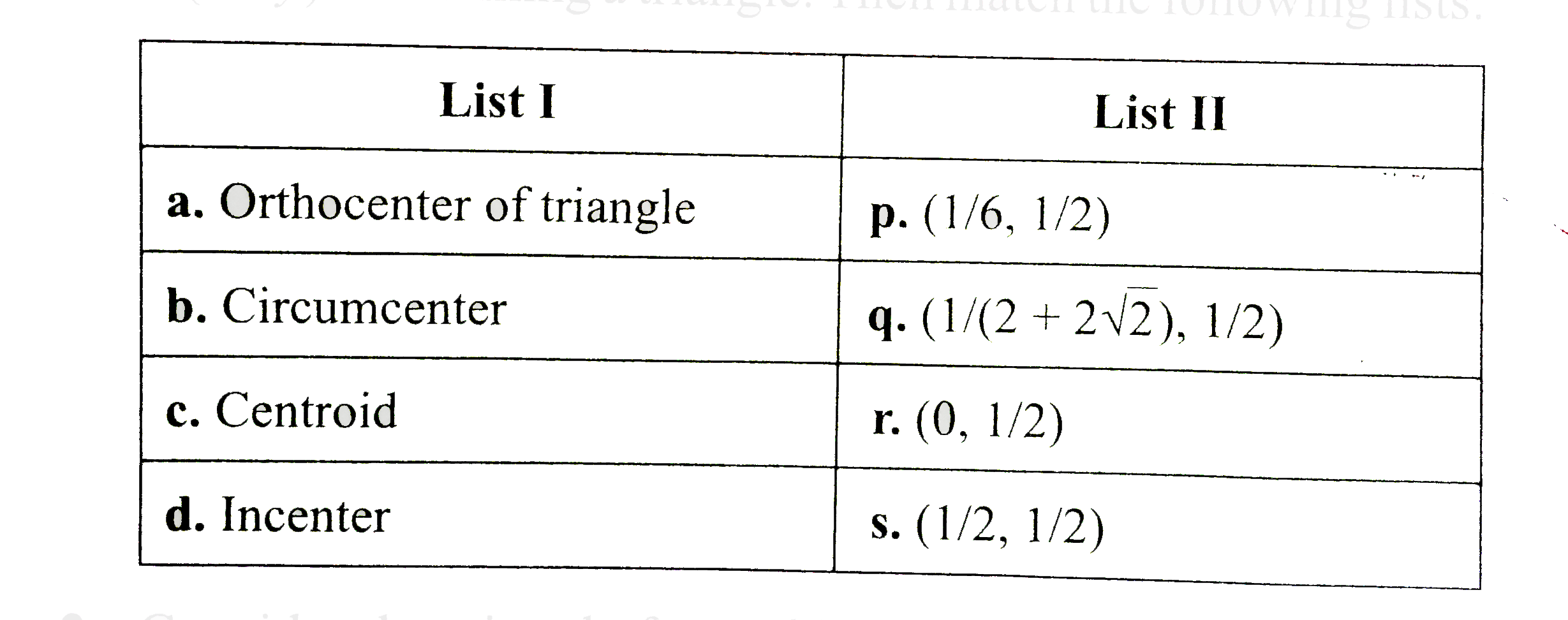If all the vertices of a triangle have integral coordinates, then the triangle may be (a) right-angle (b) equilateral (c) isosceles (d) none of theseSolution in Bengali
right-angled
equilateral
isosceles
none of these
The correct Answer is:A, C
NA
Topper's Solved these Questions
- BOOK - CENGAGE PUBLICATIONCHAPTER - COORDINATE SYSYEM EXERCISE - Linked10videos
COORDINATE SYSYEM
- BOOK - CENGAGE PUBLICATIONCHAPTER - COORDINATE SYSYEM EXERCISE - Matrix match type4videos
COORDINATE SYSYEM
- BOOK - CENGAGE PUBLICATIONCHAPTER - COORDINATE SYSYEM EXERCISE - Exercises59videos
COORDINATE SYSYEM
- BOOK - CENGAGE PUBLICATIONCHAPTER - COORDINATE SYSTEMEXERCISE - Multiple Correct Answers Type2videos
COORDINATE SYSTEM
- BOOK - CENGAGE PUBLICATIONCHAPTER - CROSS PRODUCTS EXERCISE - DPP 2.213videos
CROSS PRODUCTS
Similar Questions
For points P=(x1,y1)and Q=(x2,y2) of the co-ordinate plane a new distance d(P,Q)=|x1−x2|+|y1−y2| is defined .Let O(0,0)and A(3,2). The set of points in first quadrant which are equidistant from O and A is
04:44View SolutionConsider the lines represented by equation (x2+xy−x)×(x−y)=0 forming a triangle. Then match the following lists:
 00:48View Solution
00:48View SolutionABC is an isosceles triangle. If the coordinates of the base are B(1,3) and C(−2,7) , the coordinates of vertex A
01:24View SolutionCoordinates of points on curve 5x2−6xy+5y2−4=0 which are nearest to origin are
01:42View SolutionLet →a and →b be two vectors of equal magnitude 5 units. Let →p,→q be vectors such that →p=→a−→b and →q=→a+→b. If |→p×→q|=2{λ−(→a.→b)2}12, then value of λ is
00:52View SolutionThe polar coordinates of the vertices of a triangle are (0,0),(3,(pi)/(2))(3,(pi)/(6)). Then the triangle is (b) isosceles (a) right angled (d) none of these (c) equilateral
01:48View SolutionThe points (a,b),(c,d), and (kc+lak+l,kd+lbk+l) are (a) vertices of an equilateral triangle (b) vertices of an isosceles triangle (c) vertices of a right-angled triangle (d) collinear
05:17View SolutionThe three points (−2,2)(9,−2),and(−4,−3) are the vertices of (a) an isosceles triangle (b) an equilateral triangle (c) a right-angled triangle (d) none of these
06:59View SolutionThe points (−a,−b),(a,b),(a2,ab) are (a) vertices of an equilateral triangle (b) vertices of a right angled triangle (c) vertices of an isosceles triangle (d) collinear
02:36View SolutionIf all the vertices of a triangle have integral coordinates, then the triangle may be (a) right-angle(b) equilateral (c) isosceles(d) none of these
03:32View SolutionIn any triangle ABC if 2cos B=(a)/(c), then the triangle is(A) Right angled (C) Isosceles (B) Equilateral (D) None of these
01:09View SolutionIn triangle ABC,R(b+c)=a√bc,where R is the circumradius of the triangle. Then the triangle is
01:09View SolutionIf in a triangle (1−r1r2)(1−r1r3)=2 then the triangle is right angled (b) isosceles equilateral (d) none of these
03:14View SolutionThe three points (−2,2)(8,−2),and(−4,−3) are the vertices of (a) an isosceles triangle (b) an equilateral triangle (c) a right-angled triangle (d) none of these
02:38View SolutionThe points (−a,−b),(a,b),(a2,ab) are (a) vertices of an equilateral triangle (b) vertices of a right angled triangle (c) vertices of an isosceles triangle (d) collinear
03:41View SolutionIf all the vertices of a triangle have integral coordinates, then the triangle may be (a) right-angle (b) equilateral (c) isosceles (d) none of these
05:17View Solution

